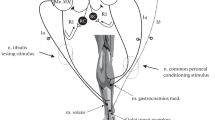Abstract
The nerves to plantaris and soleus muscles in the cat were stimulated with maximal single shocks and with random stimulus trains which produced partially fused contractions. In order to obtain information on the mechanism of muscular contraction, the effects of allowing the muscles to shorten against various elastic loads were studied in the time domain and in the frequency domain. When springs of increasing stiffness were placed in series with the muscle, the twitch tension increased greatly. The gain of the frequency response curve was also much greater with stiffer springs. The shape of the frequency response curve for plantaris muscle could usually be described by that expected for a second-order system with two real time constants or rate constants. The rate constants changed in qualitatively similar ways in response to increased stiffness of an elastic load, increased muscle length and increased mean rate of nerve stimulation. These results are in agreement with the hypothesis that the linear responses of muscles working against elastic loads are determined by the values of two rate constants. Thus, of the many processes associated with contraction, only two are rate-limiting: one associated with the viscoelastic properties of muscle and the second associated with the reuptake of Ca into the sarcoplasmic reticulum. Non-linear aspects of muscular contraction are also discussed. These are more prominent in soleus muscle than in plantaris muscle.
Similar content being viewed by others
References
Aaron, S.L., Stein, R.B.: Comparison of an EMG-controlled prosthesis and the normal biceps brachii muscle. Amer. J. Phys. Med. in press (1976)
Ashley, C.C., Moisescu, D.G.: The mechanism of free calcium change in single muscle fibres during contraction. J. Physiol. (Lond.) 231, 23–24 (1973)
Bawa, P., Mannard, A., Stein, R.B.: Predictions and experimental tests of a visco-elastic muscle model using elastic and inertial loads. Biol. Cybernetics. 22, 139–145 (1976)
Bendat, J.S., Piersol. A.G.: Measurement and analysis of random data. New York: John Wiley & Sons, Inc. 1966
Binkhorst, R.A.: The effect of training on some isometric contraction characteristics of a fast muscle. Pflügers Arch. ges. Physiol. 309, 193–202 (1969)
Burke, R.E., Rudomin, P., Zajac, F.E.: Catch properties of single mammalian motor units. Science 168, 122–124 (1970)
Connolly, R., Gough, W., Winegrad, S.: Characteristics of the isometric twitch of skeletal muscle immediately after a tetanus. J. gen. Physiol. 57, 697–709 (1971)
French, A.S.: Automated spectral analysis of neurophysiological data using intermediate magnetic tape storage. Comput. Progr. Biomed. 3, 45–47 (1973)
French, A.S., Butz, E.G.: Measuring the Wiener kernels of a nonlinear system using the fast Fourier transform algorithm. Int. J. Control 17, 529–539 (1973)
Gordon, A.M., Huxley, A.F., Julian, F.J.: The variation in isometric tension with sarcomere length in vertebrate muscle fibres. J. Physiol. (Lond.) 184, 170–192 (1966)
Grillner, S.: The role of muscle stiffness in meeting the changing postural and locomotor requirements for force development by the ankle extensors. Acta physiol. scand. 86, 92–108 (1972)
Henneman, E., Olson, C.B.: Relations between structure and function in the design of skeletal muscles. J. Neurophysiol. 28, 581–598 (1965)
Hill, A. V.: The heat of shortening and the dynamic constants of muscle. Proc. roy. Soc. (Lond.) B126, 136–195 (1938)
Hill, A. V.: The effects of series compliance on the tension developed in the muscle twitch. Proc. roy. Soc. (Lond.) B 138, 325–329 (1951)
Houk, J.C., Cornew, R.W., Stark, L.: A model of adaptation in amphibian spindle receptors. J. theor. Biol. 12, 195–215 (1966)
Huxley, A.F.: Muscle structure and theories of contraction. Progr. Biophys. 7, 255–318 (1957)
Huxley, A.F.: A note suggesting that the cross-bridge attachment during muscle contraction may take place in two steps. Proc. roy. Soc. (Lond.) B 183, 83–86 (1973)
Huxley, A.F., Simmons, R.M.: Mechanical properties of the crossbridges of frog striated muscle. J. Physiol. (Lond.) 218, 59–60 (1971)
Jewell, B.R., Wilkie, D.R.: The mechanical properties of relaxing muscle. J. Physiol. (Lond.) 152, 30–47 (1960)
Joyce, G.C., Rack, P.M.H.: Isotonic lengthening and shortening movements of cat soleus muscle. J. Physiol. (Lond.) 204, 475–491 (1969)
Joyce, G.C., Rack, P.M.H., Westbury, D.R.: The mechanical properties of cat soleus muscle during controlled lengthening and shortening movements. J. Physiol. (Lond.) 204, 461–474 (1969)
Julian, F.J.: Activation in a skeletal muscle contraction model with a modification for insect fibrillar muscle. Biophys. J. 9, 547–570 (1969)
Mannard, A., Stein, R.B.: Determination of the frequency response of isometric soleus muscle in the cat using random nerve stimulation. J. Physiol. (Lond.) 229, 275–296 (1973)
Marmarelis, P.Z., Naka, K.: White noise analysis of a neuron chain: an application of the Wiener theory. Science 175, 1276–1278 (1972)
Milsum, H.H.: Biological Control Systems Analysis. New York: McGraw-Hill 1966
Nichols, T.R., Houk, J.C.: Reflex compensation for variations in the mechanical properties of a muscle. Science 181, 182–184 (1973)
Podolsky, R.J., Nolan, A.C., Zaveler, S.A.: Cross-bridge properties derived from muscle isotonic velocity transients. Proc. nat. Acad. Sci. (Wash.) 64, 504–511 (1969)
Rack, P.M.H., Westbury, D.R.: The effects of length and stimulus rate on tension in the isometric cat soleus muscle. J. Physiol. (Lond.) 204, 443–460 (1969)
Stein, R.B., Wong, E.Y.-M.: Analysis of models for the activation and contraction of muscle. J. theor. Biol. 46, 307–327 (1974)
Stein, R.B., Oguztöreli, M.N.: Tremor and other oscillations in neuromuscular systems. Biol. Cybernetics 22, 147–157 (1976)
Weber, A., Murray, J.M.: Molecular control mechanisms in muscle contraction. Physiol. Rev. 53, 612–673 (1973)
Wong, E.Y-M.: Theoretical and experimental studies on frog skeletal muscle. M.Sc. Thesis, University of Alberta, Edmonton, Canada (1972)
Author information
Authors and Affiliations
Additional information
Graduate student of the Medical Research Council of Canada.
Formerly a Post-doctoral Fellow of the Muscular Dystrophy Association of Canada.
Rights and permissions
About this article
Cite this article
Bawa, P., Mannard, A. & Stein, R.B. Effects of elastic loads on the contractions of cat muscles. Biol. Cybernetics 22, 129–137 (1976). https://doi.org/10.1007/BF00365523
Received:
Issue Date:
DOI: https://doi.org/10.1007/BF00365523



